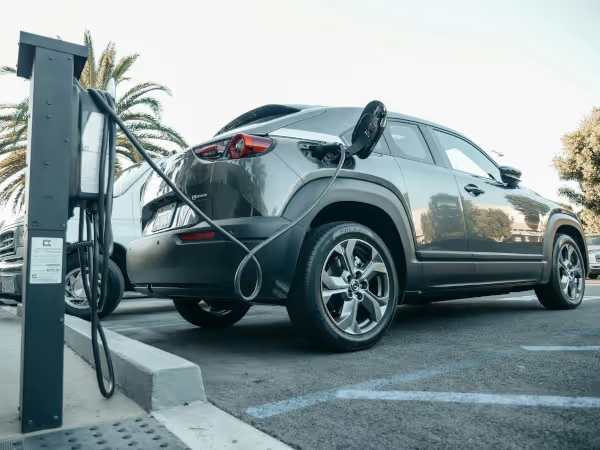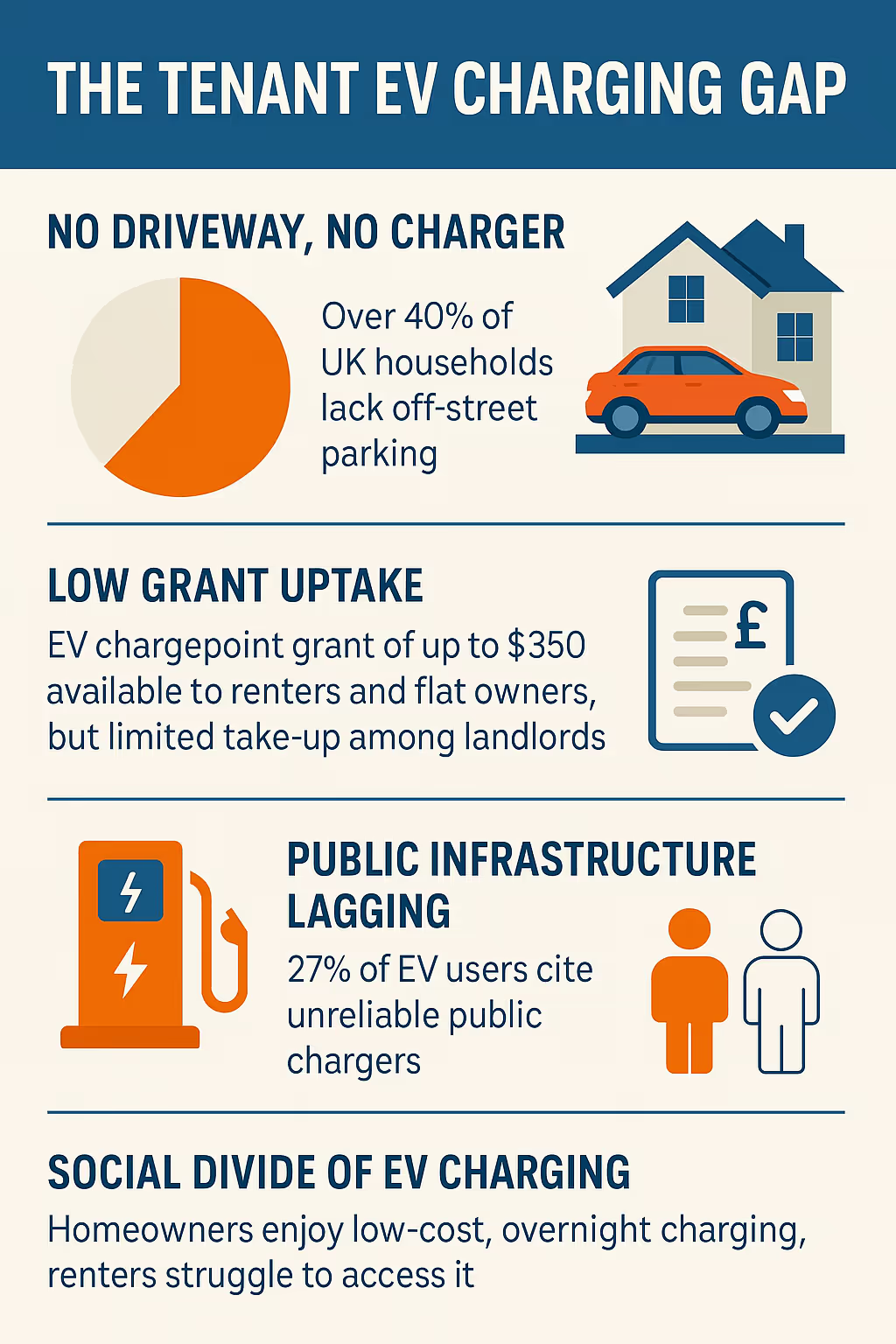




They are “plugged out”; why tenants are struggling to charge their electric vehicles
As more people adopt electric vehicle (EV) ownership in the UK, this group of people will include thousands of tenants in the not-too-distant future. Unless things change, 80% of new cars and 70% of new vans sold in Great Britain will now be zero emission by 2030, increasing to 100% by 2035. There will be no new internal combustion (IC) petrol and diesel engine cars sold after 2035 and the bulk of them will be banned by 2030.
The ruling puts the UK slightly out of step with Europe and North America. In the EU, the sale of new petrol and diesel cars will not be banned until 2035. In the USA there’s no federal law prohibiting the sale or ownership of gasoline-powered vehicles nationwide. The regulations in place there will primarily focus on phasing out the sale of new IC engine vehicles over time, though some states like California will ban the sale of new gasoline and diesel-powered vehicles from 2035.
So, as EV sales increase, tenants across the UK rental sector - these are the people most likely to live in terrace properties and flats with no access to charging points - will be left behind in the race to go green. A growing divide is going to emerge between homeowners able to access home charging points and those owners and renters who are struggling to plug in.
According to the Department for Transport, over 1.1 million EVs were on UK roads by mid-2025, yet only around 50,000 publicly accessible charging devices were available. The gap is more than just an inconvenience – it’s a major barrier to EV adoption.

There’s a financial penalty too - public EV charging points are generally more expensive than home charging, often significantly more expensive. As a rough generalisation, public charging can cost anywhere from 32p to 85p per kWh, while home charging can be as low as 9-10p per kWh, especially when used overnight on off-peak tariffs. It would mean that to fully charge a large battery electric vehicle at a public rapid charger could cost upwards of £60, while the same charge at home could be under £5.
For owners and tenants of flats or terrace houses without driveways or a garage, accessing EV charging at home presents considerable difficulties and requires alternative solutions.
Public charging networks are one, albeit expensive solution. Charging the vehicle at work is another though not ideal solution, whereas exploring the possibility of on-street residential charging schemes, chargers on lampposts or having cables running through gullies has been suggested.
None of these solutions would seem ideal for the over 40% of the population cut off – unplugged – from the mains charging network. Most landlords would be more than willing to consider providing the necessary charging outlet needed for EVs, but cost is one issue, and the technical issues will likely stymie their efforts. Even when private parking spaces are available, there are planning regulations, expensive wiring upgrades, and freeholder restrictions (particularly in leasehold flats) to contend with.
At present, landlords are under no legal obligation to provide EV charging for tenants. While proposals under the Future Homes and Buildings Standard and Zero Emission Vehicle (ZEV) mandate suggest that infrastructure requirements may soon be extended to existing buildings, details remain vague and timelines uncertain.
By contrast, all new residential developments must now include EV charge points under Part S of the Building Regulations (2022) – but these rules don’t apply to retrofits or conversions.
This regulatory uncertainty leaves landlords in limbo. Investing in EV infrastructure now may be forward-thinking – but without clarity on cost recovery, tenant demand, or legal necessity, many simply prefer to wait.
Campaign groups like FairCharge and the AA have called for greater public investment in on-street chargers, tenant protections, and landlord incentives. But so far, policy has struggled to catch up with reality.
Local councils have a key role to play, but results have been mixed. Some authorities (e.g. Westminster, Oxford, Nottingham) have led the way in deploying kerbside chargers, including lamppost units and bollard-style points. Others though are lagging far behind, citing funding issues, planning constraints, and resident opposition.
The Local Government Association says councils need long-term capital funding and clearer guidance from central government. Without this, they say, the rollout will remain uneven and renters in less affluent areas are likely to fall further behind.
But while EV ownership is growing steadily, albeit not as fast as the government would like, access to charging infrastructure hasn’t kept up. Only around 50,000 public charging points are currently available nationwide – and this includes everything from rapid motorway chargers to slow lamppost units. For homeowners with driveways, charging is simple and affordable. But for millions of renters, it’s a daily struggle.
With home charging unavailable, most tenants must rely on public infrastructure or other inventive means. But the experience is far from smooth.
While the number of public chargers has grown rapidly, their distribution, reliability, and cost are major issues. A 2024 Zap-Map survey found that: 27% of EV users had experienced a broken or faulty charger in the previous month, 34% reported queues or delays at popular charging sites and 42% found the cost of public charging “significantly higher” than charging at home.
A recent study by the Social Market Foundation (SMF) concluded that renters are “significantly less likely” to own an EV, not because of cost or preference, but because they lack somewhere to charge it. It’s a challenge that disproportionately affects lower-income, younger, and urban populations – the very groups the government hopes to get on board with the green transition.
Landlords, for their part, often lack both the incentive and the infrastructure to act. Retrofitting a property for EV use – particularly blocks of flats, HMOs, or houses with shared driveways – can be prohibitively expensive. Running dedicated cabling, upgrading supply meters, securing permissions from freeholders, and meeting safety standards is a complex process, especially when no long-term tenancy is guaranteed.
The government estimates suggest that an average of over 40% of UK households don’t have a private driveway and that figure jumps to over 70% in urban rental areas like city centres. Without dedicated parking, tenants or their landlords could be wasting their time and money installing inaccessible chargers.
The government is trying to support occupiers using the EV Chargepoint grant aimed at renters and flat owners, though so far uptake has remained low. The grant, which provides up to £350 towards the cost of installation, or 75% of the cost, whichever is lower, is there to help landlords or tenants reduce the cost of installing home charging points for eligible electric vehicle owners - those in flats or other rental properties where they have a designated, shared hub or private off-street parking space. But landlords often cite uncertainty over cost recovery, limited tenant demand, and unclear legal obligations as major deterrents.
“Until it’s clear whether we must install EV chargers, it’s hard to justify the spend,” said one London-based landlord. “We’re already under pressure from EPC regulations, licensing costs, and tax changes.”
At present there’s no legal requirement for landlords to provide EV charging points in their rental properties, but it is expected this will change.
With at-home charging out of reach, renters must rely mainly on public networks. However, as explained, access, reliability, and cost remain sticking points. According to Zap-Map, 27% of EV users cite unreliable public chargers as their biggest frustration. For tenants, this often means queuing for access, paying premium rates, or making miles of detours just to find a working plug.
There’s growing concern that the EV transition risks becoming socially divisive. Those fortunate occupiers – both homeowners and tenants – with garages and driveways, and to some extent those with off road designated parking spaces, enjoy low-cost, overnight charging. Renters, by contrast, are more likely to have to find alternative solutions and pay far more, waste their time, and face greater range anxiety.
Stephen Woodcock, a 64-year-old disabled tenant in Sheffield, as one example, is having severe difficulties as his landlords have asked him to stop charging his electric vehicle outside his home with a long cable.
Even though in his case he can park his car near a window, through which he runs the mains cable, he is being prevented from doing so – he has been told he must no longer use that method on safety grounds.
His landlord says that the reason they turned him down is because it’s a communal car parking space, and he would need to have his own designated space. They say it’s important that charging wires or cables do not cause any disruption to footpaths or access points, though they have said they want to look at a better solution for the future.
They can start to think now about EV charging for tenants. Not all situations will lend themselves to providing charging points, but in some cases, with a little imagination, the difficulties can be overcome.
Landlords have a choice: they either invest to attract a growing cohort of eco-conscious tenants, and thereby futureproof their properties, or wait for regulations to force them to do it.
Some of the large-scale professional landlords and Build to Rent scheme operators are taking the initiative now, leading the way by allocating designated parking or installing shared charging hubs. They are even bundling access to charging into tenancy agreements. But small-scale landlords often face greater difficulties given the configurations and vehicle access restrictions to their properties.
Take a close look at your rental properties to identify which ones could accommodate charging installations, including those houses with driveways and garages, or your terrace properties with rear access, and flats with designated or shared parking hubs.
Explore collaborative charging partnerships - charging providers such as Pod Point, Zaptec, Ohme. These companies can offer landlord packages or shared revenue models for multi-unit buildings.
Explore funding options: Use the EV chargepoint grant or partner with chargepoint providers for subsidised installs – see Electric vehicle chargepoint and infrastructure grants for landlords
Keep up to date with the latest developments - monitor policy developments from DfT, DLUHC, and local councils.
As EV ownership becomes more common, policymakers will want landlords to tackle the growing access gap. The government doesn’t want tenants to be penalised for choosing to rent and not having charging facilities at home.
The authorities are beginning to work on a coordinated effort – local councils and central government say they will be working with landlords in the near future to ensure that the move over to EVs is as inclusive as it can possibly be.
• Department for Transport (2025), EV Statistics Q2
• Office for Zero Emission Vehicles, EV Chargepoint Grant for Landlords and Renters
• Social Market Foundation (2024), Plugged Out: The Inequality of the EV Transition
• Zap-Map (2024), EV Charging Survey Report
• FairCharge UK, Campaign for Fair Charging Access
• Local Government Association, EV Next Steps
• HM Government, Part S Building Regulations (2022)
[Main image - credit Kindel media]
Tags:
Comments